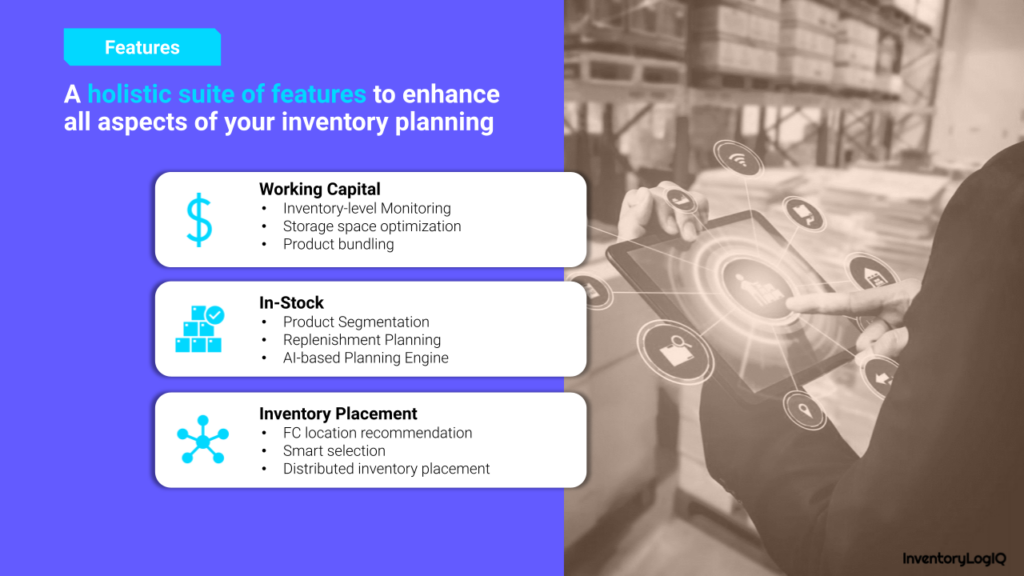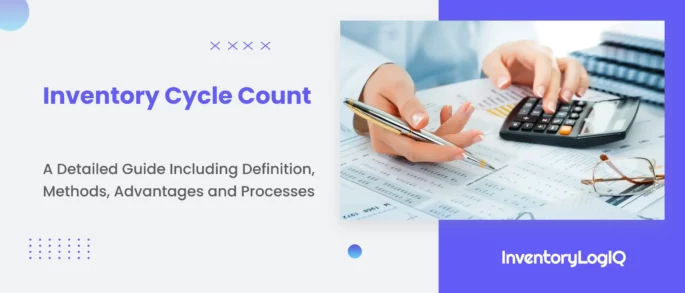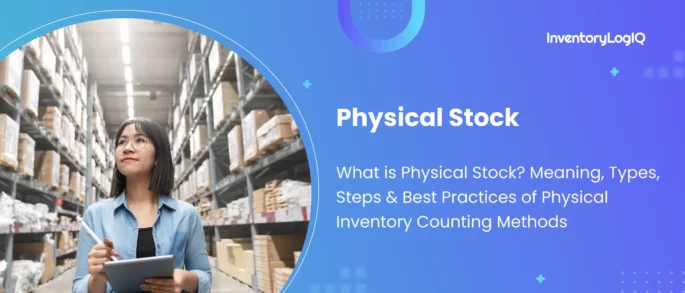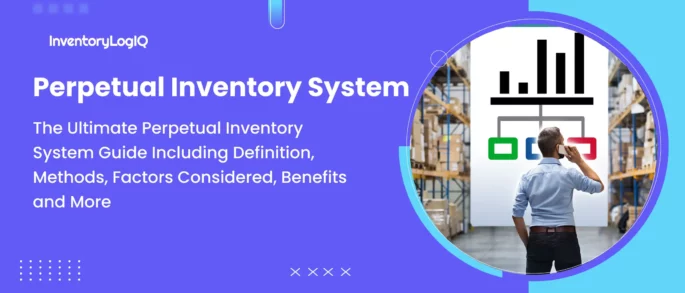Inventory Optimization 101: Definition, Importance, Challenges & 10 Best Practices to Optimize Inventory in Supply Chain in 2023
Inventory plays a vital role in generating revenue for eCommerce businesses. Because it is such a valuable resource, it is in the best interest of retailers to have practices in place to make the best use of it to avoid wastage and higher costs involved in storage. This is where inventory optimization comes into play, to be able to streamline inventory management to get the most out of it. In this blog, we will be discussing the meaning of inventory optimization, its importance, challenges, and 10 strategies to implement it.
- What is Inventory Optimization?
- Key Elements of Inventory Optimization in Supply Chain Management
- Why is Optimizing Inventory Important in eCommerce?
- Challenges of Inventory Optimization in Supply Chain Procedures
- 10 Best Strategies to Optimize Your Inventory in 2023
- Conclusion: How Can InventoryLogIQ Help With Inventory Optimization?
- Inventory Optimization FAQs
What is Inventory Optimization?
Inventory optimization refers to a series of best practices that allow an organization to use the least amount of capital while maintaining an optimum level of inventory that has a high turnover rate. It forms a part of inventory management that depends on the supply and demand scenario that is faced by the organization.
Inventory optimization in supply chain management helps control stock quantities by employing real-time data-gathering tools and processes to keep track of your stock. It facilitates investment management set against your business goals and supply targets and also empowers better demand forecasting.
[contactus_gynoveda]
Key Elements of Inventory Optimization in Supply Chain Management
Inventory Optimization in supply chain management involves the following elements:
Forecast Demand
Forecasting accurate inventory demand is crucial for your sales cycle as incorrect predictions can affect the supply and sales numbers. Therefore, you need to consider the following numbers for proper analysis of the upcoming demand.
- Supply and demand numbers in the previous period
- Accounting sales data
- Feedback and suggestions from your sales personnel
A correct demand forecast can do wonders for your inventory optimization. It can save you from stockouts and prevent you from missing your sales targets.
Suggested Read: What is Inventory Accuracy?
Analyze Inventory Levels
Overstocking can freeze unnecessary amounts of your capital and understocking can lead to missed sales targets and a dip in revenue. That’s why analyzing inventory levels is a critical part of inventory optimization.
This analysis further helps you draft an inventory policy for your organization. You can categorize products based on their consumption and demand. As a result, you can replenish the fast-moving products more frequently and in larger quantities and refill the slow-moving inventory less regularly.
In addition, you can avoid a stockout due to sudden demand surges by frequently analyzing inventory levels.
Check on Inventory Storage
Optimized stock storage is a necessity for smoother operations. A robust inventory management system helps you be ready to consistently meet customer demand and nurture business growth. You should often check the inventory levels to calculate the reorder point and order quantities. This monitoring enables you to convert the numbers into actual orders.
Briefly, it helps you ascertain when to replenish the stock to avoid missing the demand-supply gap.
Why is Optimizing Inventory Important in eCommerce?
Inventory Optimization holds a high value and can be a game-changer for players in the eCommerce industry. This line of business is highly dynamic, volatile, and prone to sudden changes in demand, thus profoundly influencing the supply of products.
Here are a few factors as to why inventory optimization in supply chain management is critical for eCommerce businesses:
Mitigates Recurring Costs
Overstocking leads to frozen capital that does not bring immediate profits and may even result in the occurrence of losses. Conversely, understocking leads to lost sales. In the eCommerce industry, volatility adds to financial losses. You can reduce your supplier lead time when you have accurate information about your stock levels.
Effective inventory optimization can highlight the recurring flow of expenses relating to purchases, transport, logistics, and many more, thus helping you curb them and avoid any probable losses.
Provides Access to Faster Delivery
Inventory optimization in the supply chain assists businesses to monitor their warehouse and SKU performance. As a result, you have relevant knowledge about the inventory presence across locations which helps you allocate merchandise where it is needed.
For instance, if the demand for product A is more in Delhi, you can allocate its bulk quantities to be stored in a warehouse close by. This promotes timely and faster delivery and adds to the customer experience. Additionally, because inventory placement is organized, it takes less time to locate inventory, package it and send it out for delivery. An advanced WMS such as the one offered by InventoryLogIQ can automate these processes to make life easier for you.
Suggested Read: Factors to Consider While Allocating Inventory in eCommerce
Stabilizes Inventory Levels
Inventory optimization gives you complete visibility of the existing stock levels and their locations from the moment they arrive at your warehouse till they are dispatched and delivered to the end customer. Such insight also informs website users when a product is in stock, out of stock, or taken off the inventory list. This tool empowers you to track your website orders more efficiently and can result in fewer lost sales and greater customer satisfaction.
Enhances Customer Satisfaction
Every customer expects an accurate and timely flow of information from eCommerce companies. If their desired item is out of stock, notify them as to when it will be replenished. Inventory optimization helps you gather this data regularly and make it available to the customer.
It provides critical insights into customer behavior, and preferences and, thus, enhances their experience with your brand. Automated inventory management also keeps a tab on the flow of merchandise flow and when replenishment is required. This information can be synced to the online website, thus enabling customers to receive transparent information and enabling them to make the right purchase decision.
Prevents the Occurrence of Overstocking & Understocking
Inventory optimization helps in forecasting future demand based on historical data to assist in avoiding overstocking and understocking situations so that just the right amount of inventory can be stored to be able to fulfill orders, mitigating the wastage of time, inventory, money, and other resources. Both overstocking and understocking are counterproductive to your capital inflow and can adversely affect your business results.
Challenges of Inventory Optimization in Supply Chain Procedures
Supply Chain Disruptions
Many factors such as global health crises, natural calamities, or even disruptions within the organization such as the wrong product being packed at the warehouse, the product incurring damage while in transit or the failure of a machine during can manufacturing, can cause an interruption in the supply chain. It increases the pressure on businesses to enable effective inventory optimization to keep it secure from unforeseen adversities.
Reacting to Unstable Consumer Demand
Your business must be ready for volatile customer expectations and sudden demand surges for some products. Sometimes, requests for a particular item escalate overnight and only a few players in the market can supply. This is a big challenge for inventory optimization because inventory forecasting sometimes cannot predict sudden surges and falls in customer demand for various products. This is why it is imperative for firms to keep some buffer stock aside to have a safety net for similar situations.
Maintaining Frequency of Order Fulfillment
Challenges in operational functions and supply chain management can constantly disrupt your inventory optimization procedures. While you may try to fulfill customers’ expectations, your stock level depends on the sales targets, the need for a stock refill, and pushing out existing inventory at the earliest. Each process needs to be optimized so the chances of it causing a disruption to the overall supply chain are minimized.
10 Best Strategies to Optimize Your Inventory in 2023
Utilize Supply Chain KPIs
You can only improve what you can monitor. Deciding and implementing KPIs for your supply chain can keep track of your logistical performance and highlight deviations for you to work on. There are multiple KPIs so you need to determine which ones would be the best to track the performance metrics of your supply chain, based on the goals you want to achieve. Some common supply chain KPIs are inventory turnover rate, fill rate, inventory days of supply, and much more.
Use ABC Analysis
ABC analysis utilizes the Pareto principle, which opines that 80% of the results are determined by 20% of the causes. Therefore, it is effective to categorize your inventory into A, B, and C classes depending on their consumption value within a fixed period.
The three categories are as follows:
- A: Products with the highest consumption value or sales
- B: Products with medium consumption value or sales
- C: Products with the lowest consumption value or sales
Each of these categories is based on SKU profitability and enables different restocking strategies for other products. For instance, if you sell washing machines worth Rs 25,000 each and a cover worth Rs 250 for each piece, you will stock them differently as per their values.
Organize Slow and Obsolete Stocks (SLOB)
Slow inventory is the gradually-moving stock that doesn’t get sold frequently. Obsolete inventory is the merchandise that has reached the end of its product life cycle. These products may not have been dispatched from the storage unit in a long time, which can be anywhere from a year to much longer, depending on their perishability. This dead inventory is a grave situation that indicates poor inventory management.
These two versions of the stockpile in your warehouse demand your attention for inventory optimization in supply chain management. First, your records must highlight the inventory that hasn’t moved in a while or moves rather slowly. These stockpiles must be attended to by either discarding them or selling them off at discounted rates.
Dealing with SLOB has some advantages:
- It creates more space for the faster-moving items
- It reduces your cost overhead
- It increases working capital
- It brings in surprise revenue from sudden sales at discounted rates to customers or vendors
Accept Shortages of Low-Demand Products
It is impossible to serve every customer that comes to your door successfully because to do that, you will need to keep 100% stock for all products, which will be financially and logistically unviable.
The only solution is to accept that being short on some low-demand or slow-moving products is good for the long-term profitability of the business because they often cost more in terms of storage and logistical fees than what they are worth. It is a small price to pay to ensure that you are always stocked with high-demand products.
Shorten Lead Time
Lead time is the waiting period between order placement and receipt from your supplier. For example, if you ordered a batch of products from your supplier today and it arrives five days later, your lead time will be five days. Lead time calculation helps in business forecasting and affects the strength of your supply chain.
When the lead time is higher, your supply chain is not as strong as it should be and your inventory cannot be optimized properly. Therefore, shorten it as much as possible to reduce carrying costs, streamline your logistical functions, improve productivity and replenishment speed, avoid stockouts and optimize inventory.
You can reduce lead time by:
- Signing a contract with your suppliers
- Increasing your reorder speed by ordering more frequently
- Share your sales information with the suppliers to alert them of an incoming order
- Employ inventory management software for better optimization
Use Proper Forecasts
Knowing how much to stock up on a particular product is as important as knowing when to do so. Predicting inventory levels can help you decide how to push sales through flash discount schemes or when to acquire more space to store your existing and incoming stock.
Besides, you need good forecasting tools to understand the nuances of safety stock and reordering.
Safety stock is the buffer you keep in hand in case of sudden demand surges or any other emergency. To calculate the safety stock you need to consider the following numbers:
- Maximum daily usage
- Maximum lead time
- Average daily usage
- Average lead time
Safety Stock = [Maximum Daily Usage x Maximum Lead Time] – [Average Daily Usage x Average Lead Time]
Your reorder point must ensure proper utilization of existing inventory levels without allowing overstocking or understocking. Here is how you can calculate it.
Reorder Point = Lead Time Demand + Safety Stock
Reduce Uncertainty in Demand and Supply
Keep a closer tab on your incoming and outgoing inventory by employing diverse automation and skilled manpower. Conduct regular audits and streamline warehouse receiving and dispatch processes.
In fact, integrating your SKUs with inventory management software can enable inventory optimization through timely and accurate tracking and updates. It gives you access to the following features:
- Real-time visibility of your stock level
- Generates alerts for restocking
- Gives suggestions on bundling options for a similar variety of products
- Churns out analytical reports for business intelligence
Centralize Your Inventory
Keeping your inventory according to demand figures is a good strategy that optimizes operations and saves expenses. Also, strategically distributing your stock at one centralized location like an inventory hub, warehouse, retail store or any other type of storage facility is financially viable as well.
In this case, only the storage facility is centralized, not the sales operations. You may have multiple stores across the county to sell your products but an SKU at one location to replenish your shelves. It helps streamline all your crucial supply chain functions under one roof.
It enhances inventory visibility and reduces storage and logistical overheads. As a result, it is suited for businesses that don’t operate in too vast and distant geographical locations.
Automate Replenishment of Inventory
Automation can help you integrate all your storage units and warehouses and monitor their inventory levels, sales channels, fulfillment centers, and delivery locations. It enhances your visibility and productivity with a constant flow of accurate data. There is a software solution to suit the needs of every business.
Robust inventory management software regulates the inventory flow from your warehouses and alerts you when a product needs replenishment or is about to become obsolete. They also give you analytical reports of inventory to observe the logistical performance.
Limit the Number of Available Products
Having a highly diversified product range does not guarantee success. However, if you keep a limited number of product offerings, you can better optimize your inventory and deliver enhanced value and a productive experience to your customers.
Apple is one of the best examples of properly utilizing a limited number of products. Their limited product range has been enough to lure queues of customers and generate massive amounts of sales.
Conclusion: How Can InventoryLogIQ Help With Inventory Optimization?
Inventory Optimization in supply chain management is crucial in influencing your business outcomes. Two supportive factors can alter the game for your business: cutting-edge technology and a team of experts.

InventoryLogIQ is an inventory optimization & smart placement program from WareIQ to help brands accelerate sales, lower operation expenditure, and offer Prime-like speed. We have been sharing Inventory Optimization Plan with our key customers like BlissClub, TCNS Clothing, Piramal Group, Future group, Wingreens etc. with the objective to improve Inventory Turnover Ratio and improve regional utilization. Plus, you get the support of our team of industry experts who have revolutionized the way the supply chain operates.





